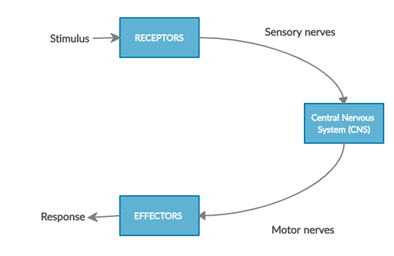
The components of a reflex arc are
A. Sensory neuron, receptor, motor neuron
B. Receptor, sensory neuron, center, motor neuron
C. Receptor, sensory neuron, center, motor neuron, effector organs
D. Motor neuron, sensory neuron, center, effector organ.
Answer
534.9k+ views
Hint: Sometimes our body reacts unknowingly because of a sudden touch of a cold or hot object. It is an involuntary action in which impulses are carried to and from the spinal cord only. A reflex is made possible by neural pathways called reflex arcs. This reflex saves us from harming our bodies. There are some examples such as corneal reflex, cough reflex.
Complete answer:
Reflex action is a process by which the body responds automatically to any action unknowingly. In such an action the brain has no role. The messages are carried by nerves to form a reflex arc. It is also called a stimulus-response model. Few common examples are like- blinking of eyes in strong lights, knee jerk, and movement of the hand in response to touch a hot or cold object.
The reflex pathway consists of the following components-
Receptor- It is a site of stimulus action, where information received and impulses generated. It is considered an end organ. When receptors are stimulated they generate an action potential in the afferent nerve or sensory nerve.
Sensory neuron- It is also called an afferent neuron. It conducts nerve impulses along an afferent pathway towards the central nervous system (CNS).
Center - the center can be referred to as the brain or spinal cord. The centra receive the sensory impulse via afferent nerves. In turn, it generates the required motor impulses.
Motor neuron- It is also called an efferent neuron.it transmits motor impulses from the center to the effector organ. An Effector organ is that organ at which motor movement is required.
Effector organs- It receives the information from the motor neuron or efferent neuron and shows appropriate responses. An effector organ can be a muscle or a gland where the activity occurs in response to the stimulus.

So the correct answer is (C) Receptor, sensory neuron, center, motor neuron, effector organs.
Note:
The reflexes are broadly classified into superficial reflexes, deep reflexes, visceral reflexes, and pathological reflexes.
Superficial reflexes - The arise from the surface of the body
Deep reflexes - they arise from the deeper tissues such as the tendon.
Visceral reflexes - they arise from the cornea or any other visceral organ
Pathological reflexes - they are seen only in some pathological conditions.
Complete answer:
Reflex action is a process by which the body responds automatically to any action unknowingly. In such an action the brain has no role. The messages are carried by nerves to form a reflex arc. It is also called a stimulus-response model. Few common examples are like- blinking of eyes in strong lights, knee jerk, and movement of the hand in response to touch a hot or cold object.
The reflex pathway consists of the following components-
Receptor- It is a site of stimulus action, where information received and impulses generated. It is considered an end organ. When receptors are stimulated they generate an action potential in the afferent nerve or sensory nerve.
Sensory neuron- It is also called an afferent neuron. It conducts nerve impulses along an afferent pathway towards the central nervous system (CNS).
Center - the center can be referred to as the brain or spinal cord. The centra receive the sensory impulse via afferent nerves. In turn, it generates the required motor impulses.
Motor neuron- It is also called an efferent neuron.it transmits motor impulses from the center to the effector organ. An Effector organ is that organ at which motor movement is required.
Effector organs- It receives the information from the motor neuron or efferent neuron and shows appropriate responses. An effector organ can be a muscle or a gland where the activity occurs in response to the stimulus.

So the correct answer is (C) Receptor, sensory neuron, center, motor neuron, effector organs.
Note:
The reflexes are broadly classified into superficial reflexes, deep reflexes, visceral reflexes, and pathological reflexes.
Superficial reflexes - The arise from the surface of the body
Deep reflexes - they arise from the deeper tissues such as the tendon.
Visceral reflexes - they arise from the cornea or any other visceral organ
Pathological reflexes - they are seen only in some pathological conditions.
Recently Updated Pages
Why are manures considered better than fertilizers class 11 biology CBSE

Find the coordinates of the midpoint of the line segment class 11 maths CBSE

Distinguish between static friction limiting friction class 11 physics CBSE

The Chairman of the constituent Assembly was A Jawaharlal class 11 social science CBSE

The first National Commission on Labour NCL submitted class 11 social science CBSE

Number of all subshell of n + l 7 is A 4 B 5 C 6 D class 11 chemistry CBSE

Trending doubts
10 examples of friction in our daily life

One Metric ton is equal to kg A 10000 B 1000 C 100 class 11 physics CBSE

Difference Between Prokaryotic Cells and Eukaryotic Cells

1 Quintal is equal to a 110 kg b 10 kg c 100kg d 1000 class 11 physics CBSE

State the laws of reflection of light

Explain zero factorial class 11 maths CBSE




